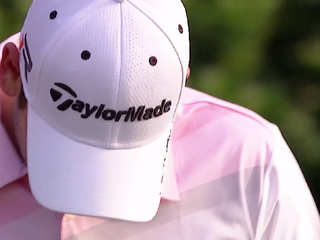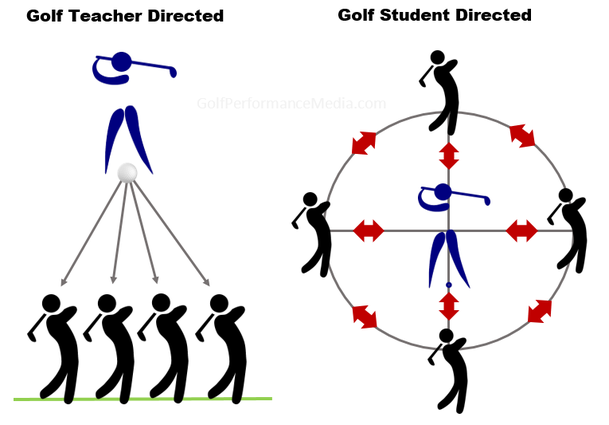|
Many golfers early in their development are indoctrinated into a cultural belief system perpetuated by the golf media and a percentage of golf teachers, where they learn to believe that to be successful at golf, you must have an excellent golf swing. The meaning behind this is that having an excellent golf swing means you will become an excellent ball striker, which further means you hit a high percentage of fairways and greens in regulation, and this will bring you much satisfaction and happiness. Yadda Yadda Yadda... There’s no doubt that because of this belief system, many golfers spend a great deal of their time perfecting swing positions through practice drills and routines, and hitting a high percentage of golf shots with the longest clubs in their bag, all with the goal of transforming themselves into a superman version of themselves—someone who swings the club technically perfect, and hits a high percentage of near perfect shots—whatever that happens to mean to them. You think I’m exaggerating? You know I’m not. A quick search on the internet around this type of motivation reveals that it is probably a mild form of delusional behavior. A delusion is a type of belief and behavior possessed by someone, that is held with strong conviction despite superior evidence to the contrary. So, the main feature of this syndrome is that golfers afflicted with this develop unshakable beliefs in something that’s not based on reality. "An excellent golf swing and shot-making ability doesn’t get close to solving the problems and challenges you face playing golf. Sure, it helps, but so does good putting. Let’s face it, no golfer however great he or she might be, hits most of their golf shots flawlessly, or swings the golf club with an extraordinary level of technical exactness."  Have you noticed that many golfers who are accomplished ball strikers, and also possess excellent golf swings, are still no happier? Go to any minor or major professional tour event and you will see many golfers with excellent golf swings, and superb shot-making ability. However, what you will also see (if you look close enough) is that many of these golfers display the danger signs of long-term frustration and disappointment, because their shots that don’t go as planned. Look, it’s fair to say that we all possess mild delusions about things that we believe to be true, even when there’s evidence to the contrary. Nevertheless, you have to wonder whether this focus on the perfection of swing techniques and golf shots is emotionally healthy. An excellent golf swing and shot-making ability doesn’t get close to solving the problems and challenges you face playing golf. Sure, it helps, but so does good putting. Let’s face it, no golfer however great he or she might be, hits most of their golf shots flawlessly, or swings the golf club with an extraordinary level of technical exactness. So, based on this presumption, it surprises us that we continue to see advanced and elite golfers with an abnormal focus on perfection of techniques, and unfortunately for them, they never learn how to manage the down-side—the times when their shots don’t turn out as expected.  Think about this for a moment, if your focus is mainly on perfecting your techniques and shot-making, then when do you learn the Emotional Intelligence strategies and skills for managing the inevitable down-side? In our experience, this is missing piece of golf instruction improvement puzzle, and consequently, golfers are left experiencing everything from mild bouts of depression, to serious bouts of anger, and everything in between, basically, they display a low E.Q. (Emotional Quotient) We don't see low E.Q. with top class golfers however. These successful golfers have developed a special kind of short-term memory (they forget fast) when it comes to hitting shots that fall short of their expectations, whereas the many who struggle with their emotions, haven’t learnt how to forget nearly as fast. The missing piece in golf development is golfers learning Emotional Intelligence (E.I.) strategies and skills. E.I. training helps you to recognize the type of emotions that interfere with your golf performance, and it also helps you to manage these debilitating emotions by forgetting them faster. So, how do we help golfers build strong E.I. strategies and skills to help them perform better on the golf course—especially when it matters? "We find that this is a helpful starting point in building a relationship with them. The fact that their beliefs might be very different to ours is not nearly as important as our ability to see their point of view first. From this position, it is easier to get them to understand how we can help them with their perceived emotional problems on the golf course."  Using E.I Rapport Building Techniques In our E.I. training, the first step is building rapport with the golfers we work with by attempting to understand ‘their way’ of relating to the down-side that they are experiencing frequently. We recognize that the way they react to less than acceptable shots is the only way they currently know, and by acknowledging the reality of their situation, we can strengthen the bonds of communication and trust with them. We find that this is a helpful starting point in building a relationship with them. The fact that their beliefs might be very different to ours is not nearly as important as our ability to see their point of view first. From this position, it is easier to get them to understand how we can help them with their perceived emotional problems on the golf course. We believe that successful communication begins and ends with our ability to create and sustain rapport with our students, and when you think about it, we make most of our important decisions in life based on the quality of relationships we have, more than anything else. Do you buy a set of golf clubs based solely on the technical merit of the clubs, or, do you buy them through a process of building a relationship with someone you like and trust? You take regular lesson with instructors that you know, like and trust. It's about building a relationship first and foremost, because the simple fact is that you are more likely to buy into an idea or concept from a golf teacher/instructor that you like, respect and agree with, rather than someone you don’t. Pace Their Experience (Building Trust) Picture if you will racing cars travelling down a road all travelling about 80 miles per hour, with each car 2 feet behind the other. Now, imagine that whatever the lead car does the trailing cars do as well. If the lead car speeds up, or slows down, or swerves, the trailing cars do this as well. What the trailing cars are doing is 'pacing' the lead car, and you can see this pacing behavior in many aspects of nature. When we are building up rapport with our students as we coach them, we are pacing their behavior, by matching and mirroring the various subtle characteristics of their behavior. We will match and mirror their language patterns, and use the same key words and descriptive phrases they use, as well as match the tone and tempo of their voice. This rapport building strategy is one of the essential building blocks for promoting trust in the relationship. With trust, we can help them change unwanted behaviors to more helpful ones, faster and more effectively. Without trust, it is unlikely that we can help them change their unwanted behaviors. "We see this a lot with junior golfers who have parents who call all the shots, and never allow their child to learn in their own best way. This is where you see the roots of bad behavior, which often becomes a long-term emotional maturity problem." Inspire Self-Directed Learning Once trust has been established, we begin encouraging our students to learn and improve in a self-directed learning environment, which in its broadest sense simply means an environment where they take more of the initiative (with our help or without) for achieving their learning outcomes. In a self-directed learning environment, our students can select, manage, and assess their own learning activities, with the overall goal being that they take ownership for their learning. If they are solely reliant on us for what they learn, they never really learn how to take full responsibility for their learning, and more importantly, their behavior on the golf course. We see this a lot with junior golfers who have parents who call all the shots, and never allow their child to learn and develop in their own best way. This is where you see the roots of bad behavior develop, which often becomes a long-term emotional maturity problem. When junior golfers don’t take full responsibility for their behavior, as they mature, those early seeds of emotional immaturity often grows into an emotional hornet’s nest. So, one of the goals of our E.I. program is centered around students developing their self-knowledge, which is where they learn to gain a better understanding of how they trigger their negative emotions, and how those emotions affect their capability when they perform on the golf course. An example of one of the ways we use self-directed learning is getting students to design their own practice or training process before they start a session. We of course supply input (if they wish), however, the idea is that they get to decide what needs to be learned, and improved, based on their present (or future) needs.
By helping our students using a self-directed learning approach, we are helping them to think independently, and take ownership of the goal development process, so they can tap into more of their unique potential to play closer to their expectations on the golf course. In our next article (part 4) we will introduce you to our goal programming process which assists our students in understanding how well-defined and crafted goals fit into the overall process of their E.I. development. So you then. Lawrie Montague and David Milne - Pro Tour Golf College www.ProTourGolfCollege.com Perth / Jakarta Comments are closed.
|
Archives
June 2019
|
Proudly Supported By
Copyright © 2011 - 2018 Pro Tour Golf College
Website Managed By Golf Performance Media
All Rights Reserved
Website Managed By Golf Performance Media
All Rights Reserved





 RSS Feed
RSS Feed



